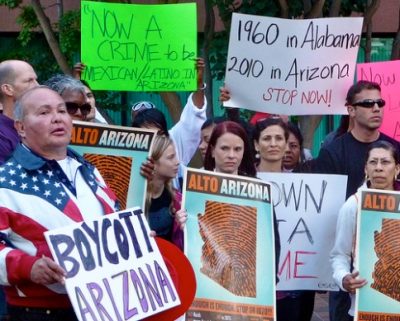Immigration at the Border

Arizona’s Punishing New Immigration Law Doesn’t Fight Crime
Supporters of Arizona’s harsh new immigration law claim that it is, among other things, a potent tool in the crime-fighting arsenal. For instance, the bill’s author, Republican State Senator Russell Pearce of Mesa, confidently predicts that the law—which requires police to investigate the immigration status of anyone who appears to be unauthorized—will result in “less crime” and “safer neighborhoods.” However, Sen. Pearce overlooks two crucial points: crime rates have already been falling in Arizona for years despite the presence of unauthorized immigrants, and a century’s worth of research has demonstrated that immigrants are less likely to commit crimes or be behind bars than the native-born. Moreover, the law is likely to distract the police from investigating non-immigration related crimes and dissuade immigrants from cooperating with the police, making neighborhoods less safe. Read More

New Arizona Enforcement Law Sparks Calls for Economic Boycott
Arizona’s new controversial enforcement law, signed into law last week by Gov. Jan Brewer, has the potential to shake down more than just undocumented immigrants and suntanned citizens. Arizona’s businesses and tourism industry are also likely to take a hit as more and more people call for an economic boycott. The law, which requires state and local law enforcement to check the documents of people they “reasonable suspect” of being here illegally, is causing many potential investors, visitors and tourists to avoid Arizona altogether. With a state budget deficit of more than $4.5 billion and an economy heavily dependent on tourism, Gov. Jan Brewer (who’s up for reelection this November) and the Arizona legislature will need to consider not only how they plan on paying for implementation of this new law, but also how to pay the larger price of doing business in a restrictionist state. Read More

New Report Reveals Devastating Effects of Deportation on U.S. Citizen Children
Everyone’s heard stories about how deportation rips apart families—or they will if Arizona’s new law is enforced. Most people think of undocumented workers when they think about deportation, but legal immigrants are often deported too. Most of these immigrants—legal and undocumented—have families, and many of those families include U.S. citizen children. When their parents are deported, it is devastating for the children. A new report by the law schools at UC Berkeley and UC Davis, In the Child’s Best Interest, looks at the deportation of legal permanent residents (LPRs or green card holders) and the impact on their kids. Read More

The Ones They Leave Behind: Deportation of Lawful Permanent Residents Harm U.S. Citizen Children
Many people believe that only illegal immigrants are deported. However, thousands of long-term legal immigrants are deported each year. While some are deported for committing serious crimes, many more are deported for committing minor, nonviolent crimes, and judges have no discretion to allow them to stay in the U.S.—even if they have U.S. citizen children. Read More

Can Arizona Afford to Implement S.B. 1070?
As the deadline for signing/vetoing Arizona’s immigration enforcement law (S.B. 1070) draws near, Arizona Governor Jan Brewer has more than just the moral and ethical implications of the law to consider. The proposed “Support Our Law Enforcement and Safe Neighborhoods Act,” a bill that makes it a misdemeanor to fail to carry proper immigration documents and requires police to determine a person’s immigration status, could come with heftier price tag than people may realize. While the Arizona legislature has not yet determined the costs associated with S.B. 1070 (the state legislature failed to attribute a cost in their attached fiscal note), several economic indicators reveal the potential cost of implementation to Arizona taxpayers and the residual consequences of driving unauthorized immigrations out of Arizona. Read More

Turning Up the Heat on Immigration: New Arizona Law Spurs Need for Immigration Reform
The passage of Arizona’s proposed anti-immigration enforcement law (SB 1070) last week has spurred an outcry of critical voices—including the Arizona Association of Chiefs of Police, religious leaders, immigration advocacy groups and a slew of political leaders—disavowing the bill as a license to racially profile and as “open season on the Latino community.” The proposed law, which Arizona Governor Jan Brewer is expected to sign Saturday, encourages Arizona police officers to investigate immigration status based on a “reasonable suspicion” that a person is in the country illegally. Yet, as the proposed law continues to garner media attention for its harsh and draconian spirit, it has also unintentionally shifted public and congressional attention toward reforming our entire federal immigration system—an overhaul that would likely discourage states like Arizona from taking federal immigration enforcement into their own hands. Read More

Keeping the Dream Alive: Sens. Durbin and Lugar Ask Administration for Deferred Deportation for DREAM Act Kids
Senators Richard Durbin (D-IL) and Richard Lugar (R-IN) have done something that is increasingly rare in Washington—they have issued a bipartisan request for a concrete change in immigration policy. Today, Senators Durbin and Lugar asked Secretary Janet Napolitano to defer deportation of students who would qualify for the DREAM Act. As the lead sponsors of this bipartisan legislation (S. 729)—which would give legal status to students who arrived in the U.S. before the age of 15, have lived in the U.S for at least five years, and are pursuing their education or serving in the military—they have a particular interest in the fate of students who are caught right now in the clutches of deportation. Read More

Razing Arizona: How Local, State and Federal Authorities are “Rooting Out” Arizona’s Immigration Problems
A perfect storm hit the state of Arizona this week. On Tuesday, the Arizona House passed SB1070—a bill which would compel local police officers to investigate people’s immigration status based on a “reasonable suspicion” he/she was in the country illegally. Two days later, Arizona residents witnessed local police descending onto their streets (along with hundreds of ICE and other federal enforcement agents) in a sweep of 52 people suspected to be part of a large-scale human-smuggling ring. More than 800 law enforcement officers took part in what was dubbed “Operation in Plain Sight”—the result of a year-long investigation targeting transportation companies allegedly involved in smuggling unauthorized immigrants across the border. According to ICE, the agents and officers represented nine federal, state, and local law enforcement agencies resulting in a large and disproportionate show of force, as 54 suspects were taken into custody. Arrests were made in Phoenix, Tucson, Nogales, and Rio Rico, as well as in Nogales, Mexico. Those arrested were charged with serious crimes—including money laundering, alien smuggling, and conspiracy. Read More

Immigration Reform Raises Revenue, While Enforcement-Only Strategies Throw Tax Dollars Away
Tax Day is a fitting time to consider the billions of dollars which the federal government wastes each year attempting to put a stop to unauthorized immigration through an “enforcement only” strategy—and the billions of new taxpayer dollars which would flow from comprehensive immigration reform that includes a pathway to legal status for unauthorized immigrants already in the United States. As the IPC points out in a new fact sheet, “we spend huge sums of taxpayer money on immigration enforcement, yet unauthorized immigrants have not been deterred from coming to the United States when there are jobs available.” As a result, enforcement resources are needlessly wasted tracking down unauthorized job seekers and people trying to reunite with family members in the United States, rather than focused on finding individuals who are actually a threat to national security or public safety. Read More

The Rise and Fall of the Secure Border Initiative’s High-Tech Solution to Unauthorized Immigration
The Secure Border Initiative (SBI), launched by the Department of Homeland Security (DHS) in 2005, is a cautionary tale of the dangers inherent in seeking a technological quick fix to the problem of unauthorized immigration. SBI calls not only for fencing the U.S.-Mexico border in the literal sense, but constructing a “virtual fence” as well. Since physical fencing can be climbed over, broken through, or dug under, it is complemented in SBI by a system of cameras and sensors—known as “SBInet”—that will, in theory, alert the Border Patrol whenever an unauthorized border crossing occurs. Read More
Make a contribution
Make a direct impact on the lives of immigrants.
